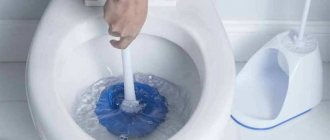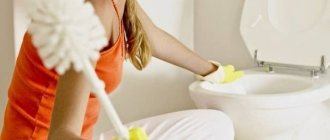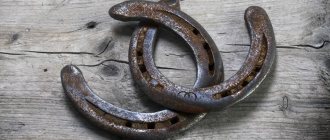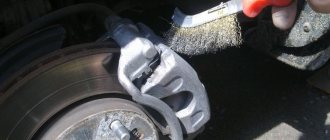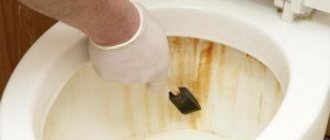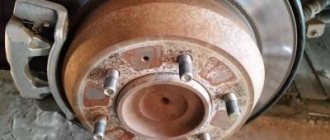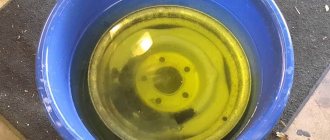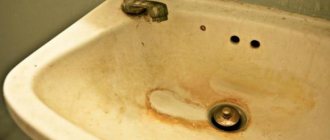Rust stains on ceramic or earthenware plumbing do not always occur, but they are very noticeable. Of course, it is simply unrealistic to wash off such streaks with water and a brush, so I want to tell you how to get rid of rust in the toilet using folk remedies or household chemicals. I will say right away that you should not delay this, since as the layer of corrosion thickens, the cleaning process becomes much more complicated and some products lose their effectiveness.
Why does dirt form in the toilet?
Most often, a yellow coating appears on the surface of the walls of plumbing fixtures, which gradually turns into noticeable lime deposits. They are collected in those places where water flows into the toilet. A predisposing factor to the accumulation of limestone is water saturated with salts. In addition, this process is also influenced by the frequency of use of plumbing fixtures - this means that the less often residents use the drain, the faster deposits accumulate.
Rusty stains
It is not uncommon for noticeable stones to accumulate on the walls of the toilet. Only in this case, the quality of the water does not affect the process, because salts are contained in human urine, which means they enter there every day. This problem often occurs when installing plumbing fixtures with a rough surface. Plaque is characterized by an unpleasant odor, which only intensifies over time, because urinary stones are a favorable environment for the spread of microorganisms.
How to clean a toilet from urinary stone? Read in detail in a special article.
The appearance of the toilet is also spoiled by traces of rust, which also appear in places where water moves from the barrel. There are several reasons for this problem:
- the water contains metals;
- the apartment has an old water supply system with rusted metal pipes;
- a broken drain barrel, causing water to constantly leak;
- presence of manufacturing defects on the walls of the toilet.
It is necessary to constantly maintain the cleanliness of plumbing fixtures
Electrolyte - removing stubborn stains
If the walls of the plumbing have lost their whiteness, an electrolyte will help correct the situation. The substance, which is an essential component of a car battery, contains sulfuric acid. It actively interacts with oxides and salts.
Since the electrolyte is poisonous, do not neglect protective accessories during cleaning. Not only will you need gloves and a face mask, but also a respirator. It is necessary to protect the respiratory system not only because of the unpleasant odor, but also because inhaling the smallest particles of electrolyte is dangerous to health.
The composition applied to contaminated areas instantly triggers a chemical reaction. The electrolyte is washed off after 15 minutes; if necessary, rust residues are removed with a brush.
Since the cleaning composition is toxic, it is recommended to use it only if the layer of rusty deposits is very large and there is no money to purchase high-quality household chemicals. You should not use electrolyte if the toilet is connected to the sewerage system with polypropylene pipes.
Toilet cleaning methods and preparation
When there is too much dirt on the walls of the toilet, it will take a lot of effort to remove them. For such purposes, various household chemicals, acids, and gentle folk remedies are used. The choice of one method or another depends on the degree of contamination of the plumbing.
Note! You should use various metal meshes to clean the toilet with caution, because they leave mechanical damage on the surface, where dirt subsequently collects.
Rigid metal mesh will only damage the coating
Before you begin the toilet cleaning procedure, you need to prepare:
- The first thing you should do is stock up on rubber gloves to protect your hands, because any alkaline products or acids have a negative effect on the skin.
- Then you will need to scoop out the water from the neck of the toilet. To facilitate this process, you can use a plunger or a large syringe.
Wear gloves when working with any toilet cleaning products.
Cleaning Recommendations
When tidying up your bathroom, follow these rules:
- First of all, choose gentle methods. Use acids and abrasives only as a last resort: improper use can damage the ceramic.
- If water leaks from the tank, turn it off during cleaning, otherwise the detergent will be washed away.
- Do not use several products from different recipes at once, especially if you are experimenting with traditional methods. Not all methods are compatible with each other.
If you use industrial chemicals for cleaning, carefully read the instructions and follow the manufacturer's recommendations.
Folk remedies for rust removal
If the pollution is not too noticeable, then you can deal with it using folk remedies, which every housewife can find. Their main advantage is that such components do not destroy the integrity of plastic water pipes. In addition, you can purchase components for cleaning the toilet according to “folk recipes” on a very budget and in any store near your home.
Citric acid: step-by-step instructions
You will need to prepare 2-3 packets of citric acid, as well as cleaning equipment: brushes, brush.
Step one: first you need to scoop out all the water from the toilet and pour citric acid into it.
The acid should cover all contaminants inside the plumbing fixtures and under the rim in a dense layer
Step two: now you need to close the toilet lid and leave it for 3.5 hours. If there are a lot of deposits and traces of rust, the holding time will have to be increased.
Upon completion of the procedure, it is necessary to rinse off the acid, and then remove any remaining dirt with a brush.
Citric acid with vinegar: step-by-step instructions
You will need to use two packets of citric acid, a third of a glass of vinegar and various tools for cleaning the toilet.
Step one: you need to pour citric acid into a dry toilet bowl as in the previous method. Then apply vinegar on top of the dirt from a spray bottle, which will react with the acid (the powder will hiss and foam).
This mixture must be left on the surface of the toilet for about four hours.
Step two: when the plaque softens, it can be easily removed with a brush
Clean the structure with a brush
Vinegar and iodine: step-by-step instructions
Step one: first of all, you need to pour vinegar into a container and burn it to about 45 degrees, you also need to add a few drops of iodine. Then the mixture must be poured into a dry toilet.
The shade of the liquid should not be dark
Step two: Next, you should take any rag (afterwards you will have to throw it away), moisten it in the bite solution and apply it to particularly contaminated areas. The toilet should be left in this form for 4.5 hours.
After a while, you will need to remove the rags and rinse the toilet with water to remove plaque.
Soda and vinegar: step-by-step instructions
There are two effective options for cleaning the toilet using baking soda and vinegar. In order to choose the right one, you need to consider them in more detail.
Option #1
You will need to prepare one glass of vinegar, a couple of tablespoons of baking soda and any container that is suitable for heating on the stove. In addition, you will need brushes, sponges, and a brush.
Step one: you need to put a container of vinegar on the stove and then boil it. Add baking soda to hot vinegar
Regular table vinegar is suitable for preparing the mixture.
Step two: before this mixture has cooled, you need to pour the dirt into it.
After a few hours, you need to rinse the toilet with clean water.
Option No. 2
During the cleaning process you will need vinegar, baking soda, a spray bottle, gloves and sponges.
Step one: First, you need to mix baking soda with water to form a thick paste.
Apply this composition to traces of dirt and rust and leave for 50-60 minutes.
Step two: now you should pour the vinegar into a spray bottle and apply it to the soda.
When this mixture stops fizzing, you will need to flush the toilet.
Step Three: The plumbing will need to be washed again with soapy water.
You can use any liquid soap
Baking and soda ash
It is necessary to prepare baking soda and soda ash in equal quantities, as well as gloves and brushes.
You will need to pour two types of soda into the toilet and leave for about 9-10 hours (it is recommended to do this at night). In the morning, all that remains is to rinse the plumbing with water. It is recommended to repeat this procedure several times.
Baking and soda ash
Other folk methods of combating pollution
There are other ways to deal with rust using improvised means:
- Sparkling water. On the Internet you can find many recipes for cleaning plumbing fixtures with the Coca-Cola drink. Indeed, soda can dissolve any deposits in 7-8 hours. To enhance the effect, you will need to pour vinegar or a packet of citric acid into the toilet. On average, about 3 liters of drink are required.
- Toothpaste. This product can be used for both internal and external cleaning of the toilet. It is recommended to use an old toothbrush (in hard-to-reach places) and a brush as a cleaning device. However, this method is only effective if there are minimal deposits.
- Dentifrice. This is another effective and affordable remedy for the population. It is necessary to pour a package of tooth powder into the toilet, and then thoroughly clean it with a brush, then rinse with water. The advantage of the product is that after the procedure a pleasant mint aroma remains.
Any carbonated drink can be used to clean the toilet.
Dentifrice
Alkaline products
Alkaline-based products are available in gel form; they have a high pH level, which allows them to quickly remove stains.
The most popular manufacturers of alkaline cleaning products:
- Bios;
- Sif;
- Baxix;
- Domestos;
- DeLaval.
Alkaline products
All these products have similar instructions for use:
- Remove water from the toilet.
- Apply the product generously along the inner walls and on the rim.
- Bid my time. The duration of action of such products ranges from 5 to 30 minutes.
- Then you will need to wash off the remaining product along with the dirt.
Note! It is not always possible to cope with rust from the first application, so such actions will have to be repeated several times.
Acids and acid-containing products
If after all the above manipulations the rust and urinary stones remain in place, then it is recommended to try strong acid-based products. It should be remembered that they are unsafe - if aggressive cleaning agents are used incorrectly, you can not only ruin your plumbing, but also cause harm to your health.
As additional protection, in addition to gloves, you will need a respirator and special glasses. Otherwise, you can get a burn to the respiratory tract or mucous membrane of the eyes.
Table 1. Acids against rust and dirt
| View, illustration | Description |
| Phosphoric acid (6%) | This acid quickly dissolves traces of limescale, rust and urinary stones. At the same time, it does not damage plastic pipes. For the cleaning procedure you will need no more than 130 grams of product, which should be left there for no more than 20 minutes. After which you will need to thoroughly wash the plumbing with water and soap. |
| Oxalic acid | This is a very caustic product that emits vapors that are hazardous to human health. It can be found on sale in the form of a light powder. It is necessary to apply oxalic acid pointwise to traces of rust (if desired, you can immediately dilute it with water). After that, the toilet must be left for 60 minutes, and then rinsed with water several times. |
| Hydrochloric acid (35%) | This is also a caustic agent that, in addition to contaminants, corrodes rubber and plastic. Therefore, you should not use hydrochloric acid in the presence of plastic pipes. In this case, you should not dry the toilet before cleaning it. You need to sleep no more than 130 grams of acid at a time. Its exposure time is about 20 minutes, after which the toilet should be rinsed several times with water. It is advisable to work with hydrochloric acid in a room where there is a good ventilation system. |
| Battery electrolyte | The main component of the electrolyte is sulfuric acid, which belongs to the category of dangerous toxic chemicals, so such a product should be used carefully. It is also not suitable for plastic sewer pipes. As with the previous method, you will need to pour about 130 grams of electrolyte into the toilet. This must be done carefully so as not to affect the plastic elements of the plumbing. Upon completion of the procedure, you should rinse the toilet with clean water and soap. |
Household products based on acids:
- "Silit Bang". A liquid product that, when sprayed, turns into a thick foam. Its action time does not exceed five minutes, it effectively copes with rusty stains.
- "Sanfor". This product allows you to clean the surface of plumbing fixtures from rust and eliminates pathogenic microorganisms.
The advantages of these liquid cleaning products are that they do not scratch the finish of plumbing fixtures and are economical to use.
Store-bought chemicals
Household chemicals intended for cleaning sanitaryware come in several types. Their main difference is the release form:
- Gel. Most often used. They usually come in bottles with an easy-to-use neck. Its shape allows you to apply the gel even under the headband. In addition, thanks to this it is possible to protect the skin from aggressive substances. The gels are applied very evenly.
- Liquid. It works in the same way as the gel, but is used less economically.
- Powder. In most cases, they are considered universal, that is, suitable for cleaning many surfaces. Their use requires the use of physical force. The abrasive components that make up the powders are quite effective at removing limescale and urinary stones. But they also have one drawback - the risk of damaging the surface.
Generally speaking, all household chemicals must meet several requirements.
- Effectively remove limescale from the surface of the toilet bowl. This is done best by those substances that contain acid. They should be used with the utmost caution. It is necessary to avoid getting the acid on the skin and its vapors into the respiratory tract.
- Remove old dirt.
- Get rid of unpleasant odors, and even better - leave a pleasant fresh aroma.
- Have an antimicrobial effect.
Illustrative examples
Let's look at some of the most effective toilet cleaners:
- Pemolux or Sarma cleaning powders. Apply to a sponge, which then needs to be thoroughly wiped over the contaminated areas.
- "Domestos". This is a thick gel that helps in the fight against complex stains. It contains hydrochloric acid. The substance acts a little slower than others. However, when using it, no effort is required to remove plaque. In addition to plaque, Domestos removes bacteria and fungus.
- Gel "Cillit Bang". Like other products, it contains hydrochloric acid. In addition to removing plaque, it perfectly whitens the surface of the toilet bowl and gives it shine. Manufacturers recommend using rubber gloves when working with the gel. One of the disadvantages of “Cillit Bang” is its rather high price.
- Comet. According to the instructions, the effect of using the gel lasts much longer than other similar products. The main active ingredient is sulfuric acid. It is this that ensures the high efficiency of Comet. The disadvantages include a pungent odor that is not overcome even by fragrance.
- Active gel “Toilet duckling”. It does not have such a thick consistency, which, however, does not affect the effectiveness. It has a pleasant smell.
- "Sanox Ultra". This substance belongs to the budget group. Quickly removes both fresh and stubborn stains. Fights all types of pollution. The only drawback is wasteful consumption.
- Gel "Sanfor". It contains chlorine, which has an antimicrobial and disinfectant effect. Actively fights mold, fungi and plaque of various origins. It is distinguished by its affordable price and versatility. The product is suitable for cleaning any surfaces.
Since almost all of the above substances contain surfactants (surfactants that make cleaning easier), alkalis or acids and chlorine, it is necessary to use protective gloves when working with them.
So, cleaning a toilet from rust and plaque is not so difficult. To do this, you can use a variety of means, from improvised ones to store-bought chemicals. Cleaning gels for the most part remove almost all contaminants, have a low price and a wide spectrum of action.
Abrasive agents against rust and plaque
Such products have the same properties as acids. They have a budget price and quickly cope with even stubborn stains. However, you should not use them too often or intensively, otherwise you may damage the toilet's coating.
Table 2. Popular toilet bowl cleaners with abrasive particles
| View, illustration | Description |
| Pemolux | This product copes even with old stains and a dense layer of plaque. Its main advantage is the absence of aggressive alkaline components. After using the product, there are no smudges left on the surface, and no pungent odor is released. |
| Sarma | A popular cleaning product that removes rust and cleans plumbing fixtures to a shine. Moreover, this cleaning powder effectively eliminates any bacteria. In particularly contaminated areas it should be kept for at least 25 minutes. |
| Sanita "Anti-rust" | This is a fast-acting product that turns into foam when used. Any dirt, including yellow stains, disappears in ten minutes. |
Prices for popular cleaning products for plumbing and pipes
Plumbing and pipe cleaners
Using bleach against rust
The well-known “Whiteness” or any other chlorine-based product quickly copes with urinary stones, plaque and rust. For best results, it is recommended to fill the toilet with bleach for 10-12 hours (at night), and then rinse thoroughly with a brush and clean water.
If desired, you can pre-rinse the plumbing with an alkaline solution, and only then use chlorine. Just remember that alkali and “Whiteness” react, so your face will also have to be protected with a respirator from harmful fumes.
“Whiteness” is a rust remover that has been proven over the years
Video
The presented videos will help you understand in more detail the rules for cleaning a toilet cistern:
About the author:
Found a mistake? Select the text with the mouse and click:
Do you know that:
Fresh lemon is not only suitable for tea: clean dirt from the surface of an acrylic bath by rubbing with half a cut citrus, or quickly wash the microwave by placing a container of water and lemon slices in it for 8-10 minutes at maximum power. The softened dirt can simply be wiped off with a sponge.
Cleaning company services
Long-term stains and old rust marks are difficult to deal with at home, so many housewives prefer to use the services of specialists. They have special equipment and a full arsenal of all devices and chemicals. The only downside is that such a service has a high cost.
However, turning to cleaning specialists for help has clear advantages. Firstly, you won’t have to waste time doing less than pleasant work. Secondly, people with respiratory problems, asthmatics and allergy sufferers, in principle, should not have contact with caustic household chemicals, and it would be more logical for each person to refuse to try to wash the plumbing on their own if they are protecting their health.
The company’s specialists will cope with pollution of any complexity
Preventing rust in the toilet
With good care of your plumbing, the appearance of rust can, in principle, be prevented, and then you won’t have to waste effort cleaning the toilet from yellow plaque:
- It is necessary to take the time to clean your plumbing regularly, at least once a week, using alkaline or chlorine-containing products.
- It is necessary to monitor the serviceability of the toilet and carry out minor repairs on time. If water leaks even a little from the tank, yellow stripes on the walls of the plumbing will appear much faster, and it will not be possible to completely remove the rust from the toilet even with the help of strong means.
- The condition of the toilet is influenced by the quality of tap water. If the water is too hard and mixed with rust from the pipes, then a yellow coating on the walls of the plumbing will appear faster. In addition, low-quality water often leads to breakdowns of the drainage system. You can solve the problem if you put special tablets in the toilet tank that help clean and soften the water.
- Rust forms faster in the toilet if the water pipes have not been replaced for too long and are rusty. It is recommended to replace old pipes; this will not only make it easier to care for your plumbing and help you clean it faster, but will also help you avoid accidents.
When using the toilet every day, it is necessary to keep it clean with a brush. You should not pour leftover food and fatty broths down the drain; all this leads to the formation of a thin greasy film on the walls of the plumbing. In this case, rust occurs faster. If the toilet is still used to dispose of food waste, then immediately after draining the remaining food, it must be cleaned with a brush.
Mistakes in caring for plumbing fixtures
To clean the toilet, it is not recommended to use soft sponges that are intended for washing dishes, because such a structure is an excellent environment for the accumulation of pathogens. Therefore, if you still had to use such a sponge, then after completing the procedure it should be disposed of.
Special long-handled devices are sold for plumbing maintenance.
If a dense layer of urinary stones and noticeable rust stains do not accumulate on the surface of the toilet, then it is not recommended to overuse cleaning products based on strong alkali or acids, because such components gradually destroy the coating.
Features of cleaning the tank
Video - Cleaning the toilet tank
Where to start cleaning?
Whatever method of cleaning the toilet you choose, you should not forget about the preparation stage. First of all, you should take care of protection. All work should be carried out only with rubber gloves.
They will protect the skin on your hands from aggressive cleansers, and you shouldn’t forget about basic hygiene. The toilet is a place where pathogens accumulate.
When working with aggressive chemicals, the use of rubber protective gloves is mandatory. Otherwise, you can develop allergies or dry out your hand skin.
For the same reason, it is advisable to wear an oilcloth or plastic apron. It is good that it covers as much surface as possible. This will prevent germs from getting on your clothes. If aggressive chemicals are to be used, a respirator should not be neglected. The respiratory tract must also be protected.
And a few more words about safety. Try to ensure that cleaning solutions do not come into contact with the skin, much less mucous membranes. If drops of the product do get on them, you should immediately wash them off with water.
When working with products with a strong odor, always leave the door to the toilet room open. The same should be done in the case when gas is formed during the interaction of cleaning agents.
It is advisable to start cleaning the toilet by removing the water. It needs to be scooped out of the device and poured out. For this it is very convenient to use a ladle with a long handle. Only after this can you begin to apply cleaning products.
Preventive actions
Of course, there are a large number of means to combat traces of rust, but in practice it is recommended to avoid such problems so as not to face the need for serious cleaning. Here are the rules to follow to ensure that the toilet always looks presentable:
- Clean the toilet every day with an organic product that does not contain alkali.
- Disinfect plumbing fixtures weekly with bleach.
- Use strong chemicals to clean contaminants at least once every 30 days.
- Check the pipes periodically - if they are rusty on the outside and inside, you will need to replace them with plastic ones.
- Treat bacteria under the toilet rim.
- Quite often, lime deposits appear in the presence of contaminated tap water. Installing special filters in the system, which will have to be changed from time to time, will help correct this problem.
It is necessary to periodically clean the toilet from plaque and rusty stains.
When choosing a toilet, it is recommended to choose products made of porcelain - this material has a smooth structure, which means it does not retain dirt and stones.
Prices for toilets, urinals, bidets
Toilets, urinals, bidets
Prevention measures
There are several ways to prevent rust:
- 1If the problem is related to poor quality water, then it is recommended to install a filter.
- 2First of all, adjust your toilet tank so that water does not leak out of it. You can do this yourself. To do this, you need to bend the float lever in the tank. This technique will reduce the amount of water used.
- 3Use of special products for water in the tank: they come in the form of soluble tablets, powder or solution. Such compositions color the water a pleasant color, refresh the air, and prevent the formation of rust and other deposits.
- 4It is recommended to replace the earthenware toilet with a new analogue, since dirt and rust settle faster on a rough surface and penetrate deeper. It is recommended to buy plumbing fixtures with a special water-repellent glaze.
- 5When choosing plumbing fixtures, preference should be given to products coated with a water-repellent substance. They are more expensive than usual, but effectively prevent dirt and rusty deposits from settling on the walls of the toilet.
- 6If minor breakdowns occur, they should be corrected in a timely manner.
- 7It is easier to remove fresh stains than old ones, so it is recommended to constantly clean the toilet and keep the toilet clean.
If you follow the above recommendations, the toilet will shine clean and last a long time.
